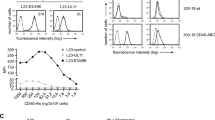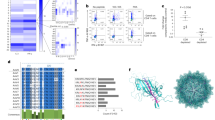Abstract
The effect of palindromic CpG sequences on the B cell response to plasmid vectors expressing a highly immunogenic viral glycoprotein was investigated. Methylation of the CpG sequences of bacterial expression vectors abolished their ability to induce an antibody response to the transgene product in mice. The antibody response could be rescued by concomitant injection of oligonucleotides carrying immunostimulatory sequences. The B cell response to two plasmid vectors, both expressing the same viral glycoprotein but containing a different content of the highly stimulatory AACGTT motif, was compared. Comparable B cell responses were induced to the two constructs given at an optimal vaccine dose while the vector containing additional palindromic sequences resulted in higher antibody titers at a suboptimal dose. These data indicate that deletion of CpG motifs or methylation of such sequences in plasmid DNA can abrogate the immune response to the vector encoded antigen and might thus enhance their usefulness as gene therapy vehicles.
This is a preview of subscription content, access via your institution
Access options
Subscribe to this journal
Receive 12 print issues and online access
$259.00 per year
only $21.58 per issue
Buy this article
- Purchase on Springer Link
- Instant access to full article PDF
Prices may be subject to local taxes which are calculated during checkout





Similar content being viewed by others
References
Yakaukas MA et al. Long term anti-nucleoprotein cellular and humoral immunity is induced by intramuscular injection of plasmid DNA containing NP gene DNA Cell Biol 1993 12: 771–777
Krieg AM et al. CpG motifs in bacterial DNA trigger direct B-cell activation Nature 1995 374: 546–551
Yamamoto S et al. Unique palindromic sequences in synthetic oligonucleotides are required to induce IFN and augment IFN-mediated natural killer cell activity J Immunol 1992 148: 4072–4076
Matzinger P . Tolerance, danger and the extended family Annu Rev Immunol 1994 12: 991–1045
Yang Y, Li Q, Ertl HCJ, Wilson JM . Lung-directed gene therapy with recombinant adenoviruses is limited by destructive class 1 restricted cytotoxic T cell responses to virus-infected cells J Virol 1995 69: 2004–2015
Yang Y, Xiang ZQ, Ertl HCJ, Wilson JM . Upregulation of class I MHC antigens by interferon-γ is necessary for the T cell-mediated elimination of recombinant adenovirus infected hepatocytes in vivo Proc Natl Acad Sci USA 1995 92: 7257–7261
Yang Y et al. Immune responses to viral antigens versus transgene product in the elimination of recombinant adenovirus infected hepatocyte in vivo Gene Ther 1995 3: 137–144
Biggs R . Jaundice and antibodies against factor VIII and IX in patients treated for hemophilia or Christmas disease in the United Kingdom Br J Haematol 1974 26: 313–329
Ehrenfort S et al. Incidence of development of factor VIII and factor IX inhibitors in hemophiliacs Lancet 1992 339: 594–598
Kay MA et al. In vivo hepatic gene therapy: complete albeit transient correction of factor IC+X deficiency in hemophilia B dogs Proc Natl Acad Sci USA 1994 91: 2353–2357
Monahan P et al. Direct intramuscular injection with recombinant AAV results in sustained expression in a dog model of hemophilia Gene Therapy 1998 5: 40–49
Klinman DM, Yamshchikov G, Ishigatsubo Y . Contribution of CpG motifs to the immunogenicity of DNA vaccines J Immunol 1997 158: 3635–3639
Hug M et al. Transcriptional repression by methylation: cooperativity between a CpG cluster in the promoter and remote CpG-rich regions FEBS Lett 1996 379: 251–254
Klinman DM et al. CpG motifs present in bacterial DNA rapidly induce lymphocytes to secrete interleukin 6, interleukin 12 and interferon γ Proc Natl Acad Sci USA 1996 93: 2879–2883
Fradin A, Manley JL, Prives CL . Methylation of simian virus 40 HpaII site affects late, but not early, viral gene expression Proc Natl Acad Sci USA 1982 79: 5142–5146
Sato Y et al. Immunostimulatory DNA sequences necessary for effective intradermal gene immunization Science 1996 273: 352–354
Jooss K, Ertl HCJ, Wilson JM . CTL target proteins and their MHC class I restriction in response to adenoviral vectors delivered to mouse liver J Virol 1998 72: 2945–2954
Tang D, DeVit M, Johnston SA . Genetic immunization is a simple method for eliciting an immune response Nature (London) 1992 356: 152–154
Ulmer B et al. Heterologous protection against influenza by injection of DNA encoding a viral protein Science 1993 259: 1745–1749
Condon C . DNA-based immunization by in vivo transfection of dendritic cells Nature Med 1996 2: 1122–1128
Porgador A . Predominant role for directly transfected dendritic cells in antigen presentation to CD8+ T cells after gene gun immunization J Exp Med 1998 188: 1075–1082
Fu TM et al. Priming of cytotoxic T lymphocytes by DNA vaccines: requirement for professional antigen presenting cells and evidence for antigen transfer from myocytes Mol Med 1997 3: 362–371
McMahon JM et al. Inflammatory responses following direct injection of plasmid DNA into skeletal muscle Gene Therapy 1998 5: 1283–1290
Ballas ZK, Rasmussen WL, Kreig AM . Induction of NK activity in murine and human cells by CpG motifs in oligonucleotides and bacterial DNA J Immunol 1996 157: 1840–1845
Wiktor TJ, Dietzschold B, Leamson N, Koprowski H . Induction and biological properties of defective interfering particles of rabies virus J Virol 1977 21: 626–633
Dietzschold BD et al. Mechanism of rabies virus neutralization by glycoprotein specific monoclonal antibodies Virology 1987 161: 29–36
Xiang ZQ et al. Vaccination with a plasmid vector carrying the rabies virus glycoprotein gene induces protective immunity against rabies virus Virology 1994 199: 132–140
Burger SR et al. Stable expression of rabies virus glycoprotein in Chinese hamster ovary cells J Gen Virol 1991 72: 359–367
Xiang ZQ, Ertl HCJ . Transfer of maternal antibodies results in inhibition of specific immune reponses in the offspring Virus Res 1992 24: 297–314
Wang Y, Xiang ZQ, Pasquini S, Ertl HCJ . Immune response to neonatal genetic immunization Virology 1997 228: 278–284
Wiktor TJ . Tissue culture methods. In: Kaplan M, Koprowski H (eds) Laboratory Techniques in Rabies. 2nd edn Vol 23: World Health Organization Monograph: Geneva 1973 pp 101–120
Acknowledgements
We wish to thank Dr L Otvos for critical review of this manuscript. This work was supported in part by the Cancer Core Support Grant from the National Cancer Institute, No. CA10815, The Wistar Institute.
Author information
Authors and Affiliations
Rights and permissions
About this article
Cite this article
Pasquini, S., Deng, H., Reddy, S. et al. The effect of CpG sequences on the B cell response to a viral glycoprotein encoded by a plasmid vector. Gene Ther 6, 1448–1455 (1999). https://doi.org/10.1038/sj.gt.3300964
Received:
Accepted:
Published:
Issue Date:
DOI: https://doi.org/10.1038/sj.gt.3300964
Keywords
This article is cited by
-
Liposome-CAT complexes induce development of a non-inflammatory neointimal lesion in rabbit carotid arteries
International Journal of Angiology (2011)
-
DNA vaccines against the human papillomavirus type 16 E6 or E7 oncoproteins
Cancer Gene Therapy (2004)



